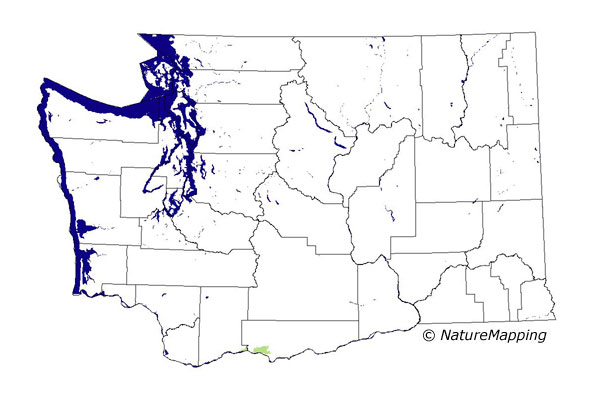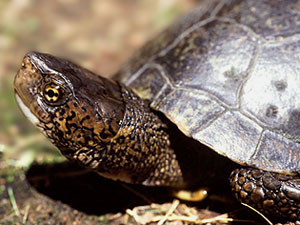


Western Pond Turtle (Clemmys marmorata) Description: The coloration of the western pond turtle ranges from brown to black on the carapace (the upper shell), with lighter marbling visible close up. The plastron (the lower shell) is black and yellow. The head and legs are dark with possible yellow markings (but not stripes like the painted turtle). Adult pond turtles range from 15-20 cm (6-8 inches) in length and weigh 448-1100 g (1-2.4 pounds). 
Dimorphism: Male has a lighter throat than the female; tail is much longer than that of female with cloaca extending past end of shell, whereas cloaca of female does not extend past end of shell; shell usually flatter and less marked than a female's, with underside concave. Range / Habitat: The range of the western pond turtle extends from the Puget Sound lowlands in Washington through western Oregon and California, south to Baja California. It was once the only species of turtle found in the Puget Sound area, and was considered common. Western pond turtles disappeared from the Puget lowlands by the 1980's, with only a few isolated adult turtles remaining. This aquatic turtle lives in streams, ponds, lakes, and permanent and ephemeral wetlands. Pond turtles spend most of their lives in water, but they also require terrestrial habitats for nesting. Click the map for information about the habitat and range of the Western Pond Turtle in Washington. Diet: Western Pond turtles are omnivorous. They eat a variety of insects, tadpoles, frog eggs, snails, leeches, aquatic beetles, dragonfly larvae and fish. Plant foods include filamentous algae, lily pods, tule and cattail roots. Reproduction: Female pond turtles usually reach sexual maturity around 10-15 years of age. Males mature quicker at 8-12 years. Mating in the wild takes place in the spring and sometimes in the fall. Nesting occurs from late May until the middle of July. Females find a suitable site, usually with dry soil, sparse vegetation and a southern exposure. The female digs a hole for the nest - first by softening the soil with urine and then scooping out the soil using her hind feet, one after the other. Once the site is prepared, she deposits a clutch of 3 to 13 eggs. After laying the eggs, the hole is filled with a mixture of vegetation and dirt to provide an air space, then covered with wet soil to keep the eggs in a humid environment. This slow process can take anywhere from two to four hours. The eggs incubate naturally underground for 90-130 days, depending on summer temperatures. Development: Hatchling pond turtles are very small - averaging 2.5-3.1 cm (1-1.2 inch) in length and weigh 3-7 g (.011-.025 ounces). They may emerge from the nest in the fall or spend winter in the nest and come out in the spring. Hatchlings are independent at birth. They rely on their natural instinct for survival including finding food. Behavior: These turtles are very shy and will dive into the water at the first sign of danger. For protection, they can quickly retract their head and legs into their hard shell. Western Pond turtles bask in groups on logs, fallen trees, and other objects near water (see photo below). The sun exposure helps rid them of parasites. In many areas turtles hibernate during the winter months by burrowing into the mud. Conservation: The western pond turtle lives up to 50 years, but reproduces relatively slowly. Females take an average of 10 years to reach sexual maturity and when mature, lay only six to 10 eggs a year. As a result, pond turtle populations can decline rapidly with the loss of only a few adults. (source: WDFW) Populations of western pond turtles are in decline due to: disease, upland and aquatic habitat alterations and destruction, in addtion to the introduction of predators. The biggest threat to the species is the bullfrog and introduced warm fresh water fish, such as bass. Both prey on small juvenile turtles. The western pond turtle (Clemmys marmorata) is listed by Washington State as an endangered species. The species is not listed under the federal Endangered Species Act. In 1990, Woodland Park Zoo, the Center for Wildlife Conservation and the Washington Department of Fish & Wildlife collaborated on a joint project to secure the future of the western pond turtle in Washington. To enhance the survival of hatchling pond turtles, females are followed to their nests and the nests are then protected with "ex-closures." These screen cages protect the eggs from predators and keep the hatchlings from wandering away when they emerge. The babies are then collected in the fall, and brought to Woodland Park Zoo for a "head-start." Young turtles are kept warm all winter and well-fed to help them grow to a size that enables them to better survive in the wild. They are then released the following summer to the wild. The newest releases in July of 2008, bring the total number of head-started turtles to around 1400.
Observations and recaptures indicate that the young turtles are surviving and doing well.
Did you know?
More Information: Project offers endangered turtles a head start to recovery, WDFW - Fish and Wildlife Science Washington State Western Pond Turtle Project Western Pond Turtle Recovery Project - Woodland Park Zoo Western Pond Turtle - Oregon Zoo Northern Pacific Pond Turtle Photo Gallery Animal silhouettes available to purchase » Photos: Chris Brown, USGS Home | About Us | How to Participate | Biodiversity Modules | Projects | Maps | News | Resources |